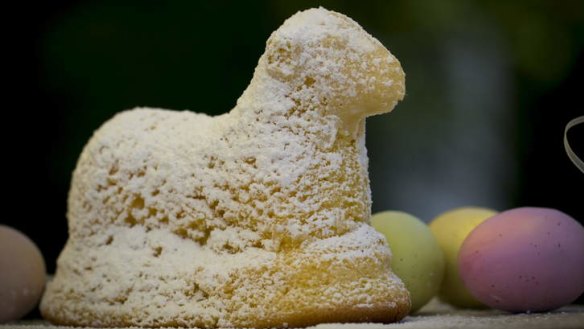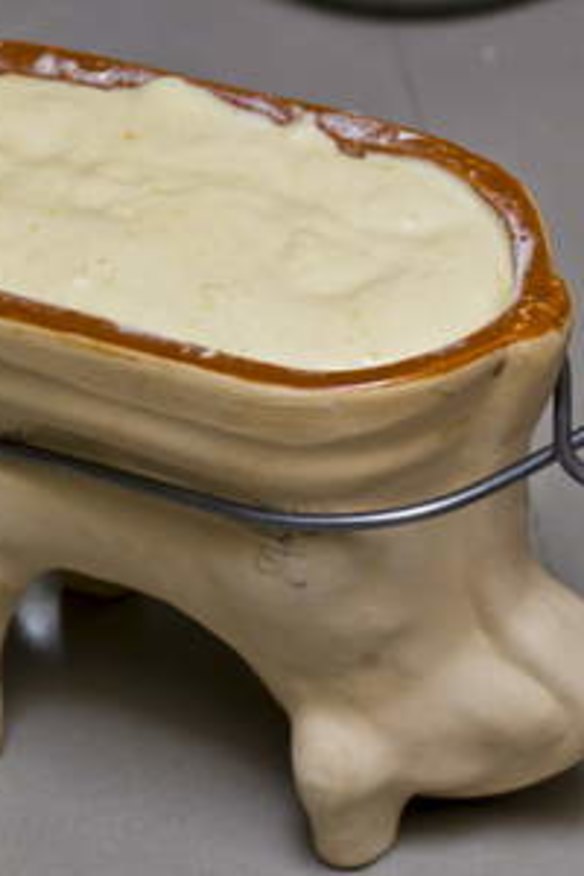Easter cake rich in tradition

Cool and dark mornings announce the onset of autumn and the approach of Easter. My dog and I have a close personal relationship with these crispish mornings, as we determinedly shed our Christmas kilos, jogging the tracks of the Majura nature park.
With this cooler weather, I inevitably begin to plan our Easter family feast. It's an odd, uncoordinated combination of Easter and school holidays this year, but we will still manage to corral friends and family to feast on a beast, slowroasted in the outdoor oven.
With a nod to body health and fitness, I avoid the obligatory Easter chocolate overdose and choose a cake that is not only sans cocoa bean, but has traditional French significance. It is in the shape of a lamb, which represents rebirth and beginnings. Most of all, I choose it because it's so very cute.

During our last visit to France, I bought some Paschal lamb pottery moulds, from the little town of Soufflenheim in Alsace, which, incredibly, has been an identified pottery region since the Bronze Age. The mould consists of two lamb-shaped sides joined together with a wire clamp. The cake mixture is poured into the greased mould and baked for 40 minutes. When cooked, it is removed from the mould and coated with a thick layer of icing sugar while still hot, ready to sit centre stage on the Easter table.
This unusual little cake is suitable for people on a dairy-free diet as it contains no milk or butter. The texture of the cake is similar to that of Italian sponge finger biscuits and it goes particularly well with a sticky dessert wine.
Any moulded or round cake pan can be used. Double the recipe to make a two-layer cake using two round 20-centimetre cake tins. Ensure you grease and line the cake tins well with baking paper to prevent the cake from sticking. If making the cake this way, serve it layered with jam and whipped cream, similar to a sponge and dust liberally with icing sugar. The undecorated cake layers will keep for a week in an airtight container.
Paschal lamb cake
Double the recipe if you plan to make two round cakes to layer with jam and cream.
3 eggs
90g sugar
100g plain flour, sifted
½⁄ tsp baking powder
1 tbsp lemon juice
zest of 1 lemon
1 tbsp Kirsch
Preheat the oven to 180C.
If using a shaped cake tin or ceramic mould, grease and flour the tin well.
For two rounded cake tins (each 20 centimetres), grease the sides well and line the bases with baking paper.
Whisk the eggs and sugar in an electric mixer for 10 minutes, until the mixture is very pale.
Sift the flour and baking powder together in a small bowl.
In the bowl of the electric mixer, add the lemon juice, zest and Kirsch to the egg and sugar mixture. Then very gently fold in the sifted flour and baking powder.
If using a shaped or moulded cake tin, place half the mixture into the tin, tapping the tin gently on the kitchen bench, to drive the batter into the details of the mould. Then fill with the rest of the batter.
If using two round tins, fill each tin equally and tap on the kitchen bench to ensure an even spread.
Bake for 20 minutes for the cake tins and 30 minutes for a moulded tin. Remove the cake gently from the tin while still hot and cool on a wire rack. Dust liberally with icing sugar.
Debbie Skelton is a Canberra food writer, debsravingrecipes.blogspot.com
The best recipes from Australia's leading chefs straight to your inbox.
Sign up